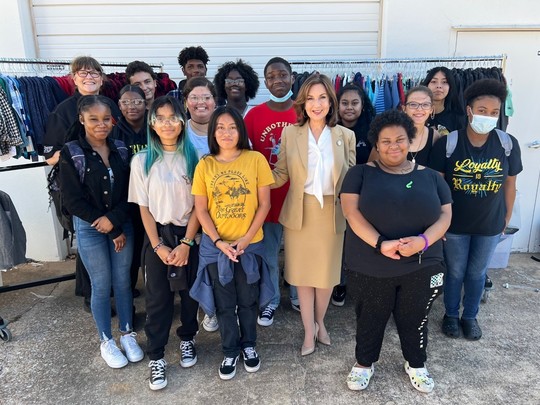 State Superintendent of Public Instruction Joy Hofmeister with the John Marshall High School FCCLA chapter in Oklahoma City.
Message from State Superintendent Joy Hofmeister: Teacher pay raise is a needed investment
I have loved traveling across Oklahoma during this first quarter of the school year and seeing all of the wonderful activities Oklahoma teachers and students are doing.
Just one of the many amazing acts of kindness I was able to see this month was the 9/11 Day of Service and Remembrance that John Marshall High School Family, Career and Community Leaders of America (FCCLA) students completed at Citizens Caring for Children. These Oklahoma City students prepared new clothing, homemade blankets and personal care items for foster children across Oklahoma. I was touched by their generosity and inspired by their willingness to serve others.
As I visit with educators, I am continually uplifted by the critical work you are doing to prepare the next generation of Oklahomans – and that needs to continue. One of the ways that I am fighting to keep teachers in the classroom and attract new, quality educators is by proposing a $5,000 teacher pay raise in next year’s state education budget.
The budget will make its way through the legislative process, but as an important first step, the State Board of Education approved the proposed budget – including the raise for all certified teachers – last week.
A pay increase for teachers is vital to build the sustainable teacher workforce necessary for the high-quality education Oklahoma students need and deserve. In the midst of an unprecedented and worsening teacher shortage, it is imperative we look for long-term solutions to show that Oklahoma values and respects our teachers.
With respect and gratitude,
 Joy Hofmeister, State Superintendent for Public Instruction
Legislators conduct packed
interim session

Following an eventful 2022 Legislative session, the Legislature has returned to the Capitol for a packed interim session. During the interim session, the period between regular lawmaking sessions, the Legislature conducts interim studies – committee hearings exploring select policy issues or topics – as requested by individual legislators. Unsurprisingly, given the amount of attention that public education received last session, House and Senate committees are approved to hear nearly 50 separate studies on education topics ranging from addressing the worsening teacher shortage to increasing school safety and security. Other noteworthy studies will focus on the community school model, barriers to student reading, the effects of four-day school weeks, best practices to increase test scores, charter school quality and sex education. These studies are among the 125 approved by legislative leadership and are eligible to be heard prior to November 5, although most education studies have been scheduled for late September or early October. The approved list of studies can be found online on the House and Senate websites, which will also provide livestreams for each study. The Legislature remains in special session for the purpose of appropriating federal American Rescue Plan (ARPA) dollars to a variety of special projects, primarily relating to state infrastructure.
|
 The power of words
By Sharon Morgan
Words are powerful. They enable us to communicate with others, read about new ideas and express thoughts and information in writing. We get excited about words from celebrating a baby’s first words to mastering a game of Wordle as an adult. A robust vocabulary increases communication skills in listening, speaking, reading and writing in all contexts and subject areas. Students with expansive vocabularies are better able to comprehend information and ultimately transition into the workforce.
The Oxford English Dictionary (2016) contains more than 600,000 entries. It is estimated that a college-educated adult knows the meanings of at least 50,000 words (Graves, 2006). A kindergarten student may know as many as 4,000 to 5,000 root words and will learn up to 1,000 new words each year (Biemiller, 1999, 2005). So many words and so little time! How do teachers in all classrooms effectively support vocabulary? Here are a few tips:
-
Pick meaningful words - Choose words that students may not know but would support the understanding of the topic. Understanding the vocabulary tiers can support choosing meaningful words. Tier 2 words are usually the best place.
-
Learn words at many levels - Talk about the word meaning, part of speech, spelling patterns, meaningful parts, and demonstrating how the word would be used either in a formal or informal way. Create a visual image to represent the word.
-
Connect the words with other words - Make a list of antonyms, synonyms, examples, various meanings, or common confusions to help solidify the understanding.
-
Use the words - Use the words in a variety of contexts including conversations, writing, games, etc. so the words become a part of the student’s knowledge bank.
Finally, “you can’t build up a vocabulary if you never meet any new word. And to meet them you must read. The more you read the better (Flesch & Lass),” so be sure to find ways for your students to interact with text independently, with others, or through a read aloud.
Increasing word knowledge for our students is a powerful way to support their listening, speaking, reading, and writing skills along with their ability to cooperate and work with others. Do you have other vocabulary strategies that work in your class? I would love to hear from you: sharon.morgan@sde.ok.gov.
Sharon Morgan is the director of elementary English language arts for the Oklahoma State Department of Education.
 New Family Guides Published
Flyers available for PreK - 6th grade students
The Oklahoma State Department of Education (OSDE) has published 58 new or updated Oklahoma Family Guides to give families a convenient way to support their children’s classroom learning at home.
The guides originally were produced in fall 2019 for core subjects – English language arts, mathematics, science and social studies – in PreK through second grade. In 2019, the OSDE added guides for the same subjects in third through sixth grades. All now include additional examples to help make student learning expectations more concrete and understandable and to reflect shifts in academic standards since that time. Guides for PreK through sixth grade are newly available for health, music, physical education and visual art.
Written by subject matter experts in the OSDE’s Office of Curriculum and Instruction, the guides include grade- and subject-specific expectations, learning goals for the school year, what to do at home to help children reach learning goals and guiding questions to foster additional skills.
Each of the guides is a printable, one-page flyer convenient for at-home use or while meeting or talking with teachers during conferences or other occasions. Guides are available by individual grades and subjects, for all subjects within a single grade and for all grades within a subject. To access the Oklahoma Family Guides, visit sde.ok.gov/oklahoma-family-guides.
News in Brief
Oklahoma among top three in nation for use of COVID relief funds
The Oklahoma State Department of Education (OSDE) and public school districts in the state have spent down more federal coronavirus relief monies than all but two other states, State Superintendent of Public Instruction Joy Hofmeister recently announced.
Data from the United States Department of Education (USDE) Educational Stabilization Fund transparency portal indicates that of the $2.3 billion the USDE has allocated to Oklahoma to support students in the wake of the pandemic, $1.033 billion had been spent by June 30, 2022, ranking the state third in the country. When taking into consideration three federal tranches of COVID stabilization funding under the Elementary and Secondary School Emergency Relief (ESSER) Fund, the OSDE and local districts have spent down 44.5% of funds. Only Iowa and Hawaii have expended a higher percentage of ESSER funds.
“Oklahoma educators have shown their commitment to serving the significant needs of more than 700,000 students impacted by the pandemic through the rapid deployment of federal COVID relief funds in the state,” Hofmeister said. “Data from the federal dashboard proves what I have known from the beginning of the pandemic – our districts were desperate for these funds and have used them to positively impact student achievement and well-being. I am confident we are well positioned to expend all ESSER funds within the timeframes established by the USDE.”
State's Healthy Schools approach featured by CDC
|
An effort to focus on how to integrate health in the school environment to combat the state's high rate of childhood obesity was highlighted by the Centers for Disease Control and Prevention this month.
The OSDE's Project Get Fit Team worked with the Oklahoma State Department of Health and the University of Central Oklahoma to implement several initiatives, including Painted Play Spaces. The initiative, which uses colorful paint and stencils to create fun, movement-oriented recess games, has shown positive results:
* A 66 percent increase in teachers and school staff playing games and being engaged with students.
* A 27 percent increase in the percentage of students who are physically active.
* More than 90 percent of students involved in physically active play.
See the CDC feature here.
|
|
 |

ShapED My Life
Joseph Harroz Jr., president of the University of Oklahoma, explains how a Putnam City Schools teacher showed him the patience, discipline and passion for teaching that led him to pursue a career in education. See the latest story in the ShapED My Life series here.
|

|